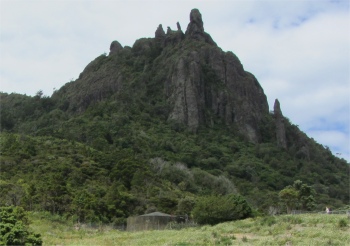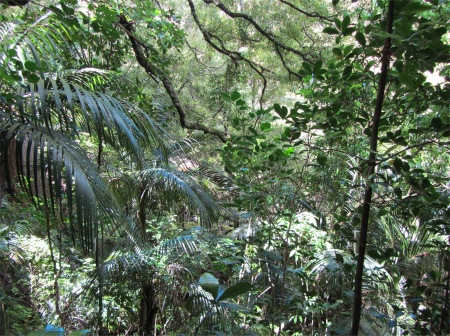
Native Bush
|
Most of my morning was spent catching up on my blog, and totally arranging the interior of my deluxe home. I had slept well, but the storage needed a total revamp.
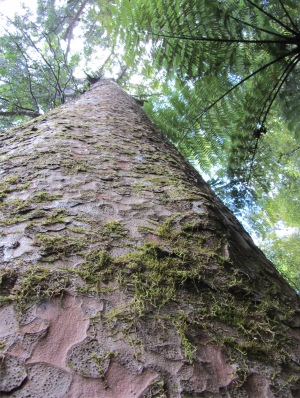
Kauri Tree
|
Once done, I headed up to the A. H. Reed Memorial Kauri Park, named after A. H. Reed, a well-known New Zealand author, publisher and long distance walker. Here a shady path wound its way amongst native bush: giant ferns with bark of similar texture to the pictures I used see of pre-historic forests as a child, variations of the palm tree family, and other trees that seemed to act as home to a host of smaller exotic bushes that grew where ever they could get a foothold in the bark or branches. A feature of the trail is the canopy walkway over the Wai Koromiko stream, which provided me with a bird's eye view of the forest. Perching lilies and hanging ferns clung high in the nooks and niches. Plants with wild names such as lycopod, spleenwort, pittosporum, kowharawhara and kahakaha lurked amongst the dense foliage. Lichens, moss and orchids were to be found in abundance too. Towards the end of the canopy I was passing through a magnificent remnant of the original kauri forests past 500-year-old trees, a typical stand of kauri rickers (juvenile trees), which were once extensive throughout Northland.
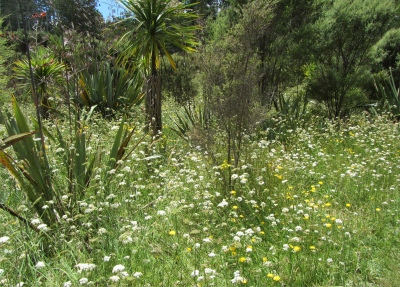
Wild Flowers among Native Bush
|
I didn't realise it at first, the placards along the way were not at all clear, and when I came across a trio of trees of massive girth, I presumed them to be kauri, but wasn't sure. A young couple passing by were not sure either. The bark of these trees was nothing like any I'd seen before, and it was totally different to the bark on the
Giant Sequoias and
redwoods I had seen in California. The surface of the trunk looked dimpled as though it had been beaten with a large ball hammer. Its surface was difficult to score, and to strike it was like punching concrete. This was a living hardwood I was eyeballing. I spotted little trails of resin or gum, and they convinced me that these were indeed kauri. I felt privileged to stand among these noble giants. As A. H. Reed stated in 1952, "A noble stand of Kauri of which the largest surpasses any of its kind so near the town. They have been growing side by side for hundreds of years and may be expected to do so for hundreds of years to come."
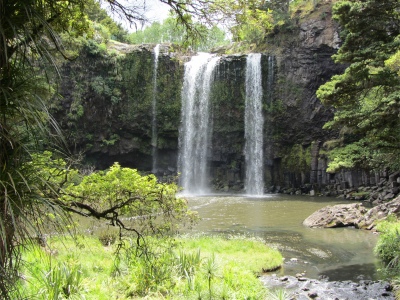
Whangarei Falls
|
Satisfied I had met these grand old men, I branched off to pick up the Hatea River. An easy stroll up stream took me along the river flats passing through open pasture land and tracts of wild flowers, and past a herd of cattle sheltering from the glaring sun under a clump of trees. Structures provided evidence of early settlers' activities and interests. I broke out of the lush bush at the foot of the Whangarei Falls. Here a curtain of water cascaded over a 26m basalt ridge into a popular swimming pool at their base. The setting was quite spectacular, the rain forest providing the perfect frame.
By the time I returned to the car, I felt as though I'd had a good walk. My next stop was the lookout at Mount Parihaka, a volcanic dome rising 241m to the northeast of the city centre. It is about 20 million years old, and part of the Harbour Fault which also includes Parakiore near Kamo, and Hikurangi near the town of the same name. The dome is surrounded by the Parihaka Scenic Reserve. From here I was afforded splendid views over the city and out across Whangarei Harbour. A War Memorial at the summit commemorates New Zealand's fallen during both World Wars, providing a sober reminder of these young men who went off to the opposite ends of the earth to sacrifice their lives for the motherland.






